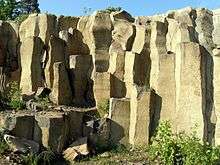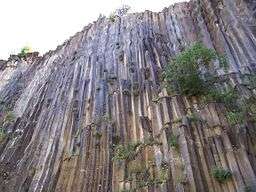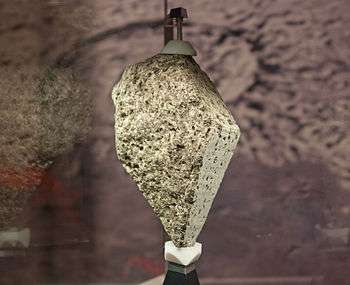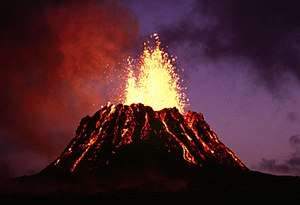Basalt
Basalt (US: /bəˈsɔːlt, ˈbeɪsɒlt/, UK: /ˈbæsɔːlt, ˈbæsəlt/)[1][2][3][4] is a mafic extrusive igneous rock formed from the rapid cooling of lava rich in magnesium and iron[5] exposed at or very near the surface of a terrestrial planet or a moon.[6] More than 90% of all volcanic rock on Earth is basalt.[7]
| Igneous rock | |
 | |
| Composition | |
|---|---|
| Mafic: amphibole and pyroxene, sometimes plagioclase, feldspathoids, and/or olivine. |
Molten basalt lava has a low viscosity due to its low silica content, resulting in rapidly moving lava flows that can spread over great areas before cooling and solidification.[8] Flood basalts are thick sequences of many such flows that can cover hundreds of thousands of square kilometers and constitute the most voluminous of all volcanic formations.[9]
Definition



Basalt is an aphanitic (fine-grained) igneous rock that is relatively low in silica and alkali metals. It has a silica content of 45–53%[10] and less than 10% feldspathoid by volume, with at least 65% of the rock consisting of feldspar in the form of plagioclase.[11][12][13] This places basalt in the B field of the TAS classification or fields 9, 9', 10, 10', and 10* of the QAPF diagram.[14] Basalt is usually dark grey to black in colour, due to a high content of augite or other pyroxene minerals,[15][16][17] but can exhibit a wide range of shading. Some basalts are quite light-coloured due to a high content of plagioclase, and these are sometimes described as leucobasalts.[18][19] Lighter basalt can be difficult to distinguish from andesite. The formal distinction is that the plagioclase in andesites is sodium-rich while that in basalts is calcium-rich, but this cannot be checked outside a laboratory, and a common rule of thumb in the field is that basalt has a color index of 35 or greater.[20] The average density of basalt is 2.9 g/cm3.[21]
Exposed surfaces of basalt outcrops rapidly weather to brown or rust-red[22][23][24] due to oxidation of mafic (iron-rich) minerals into hematite or other iron oxides and hydroxides.[25]
Basalt is often porphyritic, containing larger crystals (phenocrysts) formed prior to the extrusion that brought the magma to the surface, embedded in a finer-grained matrix. These phenocrysts usually are of augite, olivine, or a calcium-rich plagioclase,[16] which have the highest melting temperatures of the typical minerals that can crystallize from the melt[26] and are therefore the first to form solid crystals.
Basalt often contains vesicles, formed when dissolved gases bubble out of the magma as it decompresses during its approach to the surface, and the erupted lava then solidifies before the gases can escape. When these make up a substantial fraction of the volume of the rock, the rock is described as scoria.[27]
The term basalt is at times applied to shallow intrusive rocks with a composition typical of basalt, but rocks of this composition with a phaneritic (coarser) groundmass are more properly referred to as diabase (also called dolerite) or, when more coarse-grained (crystals over 2 mm across), as gabbro. Diabase and gabbro are thus the hypabyssal and plutonic equivalents of basalt.[6]

In the Hadean, Archean, and early Proterozoic eons of Earth's history, the chemistry of erupted magmas was significantly different from today's, due to immature crustal and asthenosphere differentiation. These ultramafic volcanic rocks, with silica (SiO2) contents below 45% are usually classified as komatiites.[28]
Etymology
The word "basalt" is ultimately derived from Late Latin basaltes, a misspelling of Latin basanites "very hard stone", which was imported from Ancient Greek βασανίτης (basanites), from βάσανος (basanos, "touchstone") and perhaps originated in Egyptian bauhun "slate".[29] The modern petrological term basalt describing a particular composition of lava-derived rock originates from its use by Georgius Agricola in 1556 in his famous work of mining and mineralogy De re metallica, libri XII. Agricola applied "basalt" to the volcanic black rock of the Schloßberg (local castle hill) at Stolpen, believing it to be the same as the "very hard stone" described by Pliny the Elder in Naturalis Historiae.
Types
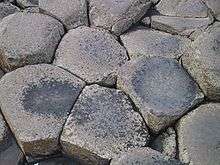
- Tholeiitic basalt is relatively rich in iron and poor in alkali metals and aluminium.[30] Included in this category are most basalts of the ocean floor, most large oceanic islands,[31] and continental flood basalts such as the Columbia River Plateau.[9]
- High and low titanium basalts. Basalt rocks are in some cases classified after their titanium (Ti) content in High-Ti and Low-Ti varieties. High-Ti and Low-Ti basalts have been distinguished in the Paraná and Etendeka traps[32] and the Emeishan Traps.[33]
- Mid-ocean ridge basalt (MORB) is a tholeiitic basalt commonly erupted only at ocean ridges and is characteristically low in incompatible elements.[34][15]
- E-MORB, enriched MORB
- N-MORB, normal MORB
- D-MORB, depleted MORB
- High-alumina basalt may be silica-undersaturated or -oversaturated (see normative mineralogy). It has greater than 17% alumina (Al2O3) and is intermediate in composition between tholeiitic basalt and alkali basalt; the relatively alumina-rich composition is based on rocks without phenocrysts of plagioclase. These represent the low silica end of the calc-alkaline magma series.[35]
- Alkali basalt is relatively rich in alkali metals. It is silica-undersaturated and may contain feldspathoids,[30] alkali feldspar, phlogopite, and kaersutite. Augite in alkali basalts is titanium-enriched augite, and low-calcium pyroxenes are never present.[36]
- Boninite is a high-magnesium form of basalt that is erupted generally in back-arc basins, distinguished by its low titanium content and trace-element composition.[37]
- Ocean island basalt[38]
- Lunar basalt[39]
Petrology

The mineralogy of basalt is characterized by a preponderance of calcic plagioclase feldspar and pyroxene. Olivine can also be a significant constituent.[40] Accessory minerals present in relatively minor amounts include iron oxides and iron-titanium oxides, such as magnetite,ulvöspinel, and ilmenite.[36] Because of the presence of such oxide minerals, basalt can acquire strong magnetic signatures as it cools, and paleomagnetic studies have made extensive use of basalt.[41]
In tholeiitic basalt, pyroxene (augite and orthopyroxene or pigeonite) and calcium-rich plagioclase are common phenocryst minerals. Olivine may also be a phenocryst, and when present, may have rims of pigeonite. The groundmass contains interstitial quartz or tridymite or cristobalite. Olivine tholeiitic basalt has augite and orthopyroxene or pigeonite with abundant olivine, but olivine may have rims of pyroxene and is unlikely to be present in the groundmass.[36] Ocean floor basalts, erupted originally at mid-ocean ridges, are known as MORB (mid-ocean ridge basalt) and are characteristically low in incompatible elements.[31]
Alkali basalts typically have mineral assemblages that lack orthopyroxene but contain olivine. Feldspar phenocrysts typically are labradorite to andesine in composition. Augite is rich in titanium compared to augite in tholeiitic basalt. Minerals such as alkali feldspar, leucite, nepheline, sodalite, phlogopite mica, and apatite may be present in the groundmass.[36]
Basalt has high liquidus and solidus temperatures—values at the Earth's surface are near or above 1200 °C (liquidus)[42] and near or below 1000 °C (solidus); these values are higher than those of other common igneous rocks.[43]
The majority of tholeiitic basalts are formed at approximately 50–100 km depth within the mantle. Many alkali basalts may be formed at greater depths, perhaps as deep as 150–200 km.[44][45] The origin of high-alumina basalt continues to be controversial, with disagreement over whether it is a primary melt or derived from other basalt types by fractionation.[46]:65
Geochemistry
Relative to most common igneous rocks, basalt compositions are rich in MgO and CaO and low in SiO2 and the alkali oxides, i.e., Na2O + K2O, consistent with the TAS classification.[14]
Basalt generally has a composition of 45–55 wt% SiO2, 2–6 wt% total alkalis, 0.5–2.0 wt% TiO2, 5–14 wt% FeO and 14 wt% or more Al2O3. Contents of CaO are commonly near 10 wt%, those of MgO commonly in the range 5 to 12 wt%.[47]
High-alumina basalts have aluminium contents of 17–19 wt% Al2O3; boninites have magnesium (MgO) contents of up to 15 percent. Rare feldspathoid-rich mafic rocks, akin to alkali basalts, may have Na2O + K2O contents of 12% or more.[47]
The abundances of the lanthanide or rare-earth elements (REE) can be a useful diagnostic tool to help explain the history of mineral crystallisation as the melt cooled. In particular, the relative abundance of europium compared to the other REE is often markedly higher or lower, and called the europium anomaly. It arises because Eu2+ can substitute for Ca2+ in plagioclase feldspar, unlike any of the other lanthanides, which tend to only form 3 cations.[48]
Mid-ocean ridge basalts (MORB) and their intrusive equivalents, gabbros, are the characteristic igneous rocks formed at mid-ocean ridges. They are tholeiitic basalts particularly low in total alkalis and in incompatible trace elements, and they have relatively flat REE patterns normalized to mantle or chondrite values. In contrast, alkali basalts have normalized patterns highly enriched in the light REE, and with greater abundances of the REE and of other incompatible elements. Because MORB basalt is considered a key to understanding plate tectonics, its compositions have been much studied. Although MORB compositions are distinctive relative to average compositions of basalts erupted in other environments, they are not uniform. For instance, compositions change with position along the Mid-Atlantic Ridge, and the compositions also define different ranges in different ocean basins.[49] Mid-ocean ridge basalts have been subdivided into varieties such as normal (NMORB) and those slightly more enriched in incompatible elements (EMORB).[50]
Isotope ratios of elements such as strontium, neodymium, lead, hafnium, and osmium in basalts have been much studied to learn about the evolution of the Earth's mantle.[51] Isotopic ratios of noble gases, such as 3He/4He, are also of great value: for instance, ratios for basalts range from 6 to 10 for mid-ocean ridge tholeiitic basalt (normalized to atmospheric values), but to 15–24 and more for ocean-island basalts thought to be derived from mantle plumes.[52]
Source rocks for the partial melts probably include both peridotite and pyroxenite.[53]
Morphology and textures
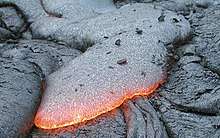
The shape, structure and texture of a basalt is diagnostic of how and where it erupted—whether into the sea, in an explosive cinder eruption or as creeping pāhoehoe lava flows, the classic image of Hawaiian basalt eruptions.[54]
Subaerial eruptions
Basalt that erupts under open air (that is, subaerially) forms three distinct types of lava or volcanic deposits: scoria; ash or cinder (breccia);[55] and lava flows.[56]
Basalt in the tops of subaerial lava flows and cinder cones will often be highly vesiculated, imparting a lightweight "frothy" texture to the rock.[57] Basaltic cinders are often red, coloured by oxidized iron from weathered iron-rich minerals such as pyroxene.[58]
ʻAʻā types of blocky, cinder and breccia flows of thick, viscous basaltic lava are common in Hawaiʻi. Pāhoehoe is a highly fluid, hot form of basalt which tends to form thin aprons of molten lava which fill up hollows and sometimes forms lava lakes. Lava tubes are common features of pāhoehoe eruptions.[56]
Basaltic tuff or pyroclastic rocks are less common than basaltic lava flows. Usually basalt is too hot and fluid to build up sufficient pressure to form explosive lava eruptions but occasionally this will happen by trapping of the lava within the volcanic throat and buildup of volcanic gases. Hawaiʻi's Mauna Loa volcano erupted in this way in the 19th century, as did Mount Tarawera, New Zealand in its violent 1886 eruption. Maar volcanoes are typical of small basalt tuffs, formed by explosive eruption of basalt through the crust, forming an apron of mixed basalt and wall rock breccia and a fan of basalt tuff further out from the volcano.[59]
Amygdaloidal structure is common in relict vesicles and beautifully crystallized species of zeolites, quartz or calcite are frequently found.[60]
Columnar basalt
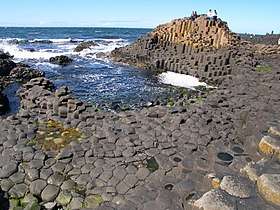

During the cooling of a thick lava flow, contractional joints or fractures form.[61] If a flow cools relatively rapidly, significant contraction forces build up. While a flow can shrink in the vertical dimension without fracturing, it cannot easily accommodate shrinking in the horizontal direction unless cracks form; the extensive fracture network that develops results in the formation of columns. The topology of the lateral shapes of these columns can broadly be classed as a random cellular network. These structures are predominantly hexagonal in cross-section, but polygons with three to twelve or more sides can be observed.[62] The size of the columns depends loosely on the rate of cooling; very rapid cooling may result in very small (<1 cm diameter) columns, while slow cooling is more likely to produce large columns.[63]
Submarine eruptions
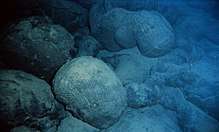
Pillow basalts
When basalt erupts underwater or flows into the sea, contact with the water quenches the surface and the lava forms a distinctive pillow shape, through which the hot lava breaks to form another pillow. This "pillow" texture is very common in underwater basaltic flows and is diagnostic of an underwater eruption environment when found in ancient rocks. Pillows typically consist of a fine-grained core with a glassy crust and have radial jointing. The size of individual pillows varies from 10 cm up to several meters.[64]
When pāhoehoe lava enters the sea it usually forms pillow basalts. However, when ʻaʻā enters the ocean it forms a littoral cone, a small cone-shaped accumulation of tuffaceous debris formed when the blocky ʻaʻā lava enters the water and explodes from built-up steam.[65]
The island of Surtsey in the Atlantic Ocean is a basalt volcano which breached the ocean surface in 1963. The initial phase of Surtsey's eruption was highly explosive, as the magma was quite fluid, causing the rock to be blown apart by the boiling steam to form a tuff and cinder cone. This has subsequently moved to a typical pāhoehoe-type behaviour.[66][67]
Volcanic glass may be present, particularly as rinds on rapidly chilled surfaces of lava flows, and is commonly (but not exclusively) associated with underwater eruptions.[68]
Pillow basalt is also produced by some subglacial volcanic eruptions.[68]
Life on basaltic rocks
The common corrosion features of underwater volcanic basalt suggest that microbial activity may play a significant role in the chemical exchange between basaltic rocks and seawater. The significant amounts of reduced iron, Fe(II), and manganese, Mn(II), present in basaltic rocks provide potential energy sources for bacteria. Some Fe(II)-oxidizing bacteria cultured from iron-sulfide surfaces are also able to grow with basaltic rock as a source of Fe(II).[69] Fe- and Mn- oxidizing bacteria have been cultured from weathered submarine basalts of Loihi Seamount.[70] The impact of bacteria on altering the chemical composition of basaltic glass (and thus, the oceanic crust) and seawater suggest that these interactions may lead to an application of hydrothermal vents to the origin of life.[71]
Distribution
Basalt is the most common volcanic rock type on Earth, being a key component of oceanic crust as well as the principal volcanic rock in many mid-oceanic islands, including Iceland, the islands of Hawaiʻi,[31] the Faroe Islands,[72] and Réunion.[73] On Earth, most basalt magmas have formed by decompression melting of the mantle.[74] Basalt commonly erupts on Io (the third largest moon of Jupiter),[75] and has also formed on the Moon, Mars, Venus, and the asteroid Vesta.
The crustal portions of oceanic tectonic plates are composed predominantly of basalt, produced from upwelling mantle below the ocean ridges.[76]
Basalt is one of the most common rock types in the world. Basalt is the rock most typical of large igneous provinces. The largest occurrences of basalt are in the ocean floor that is almost completely made up by basalt.[76] Above sea level basalt is common in hotspot islands[38] and around volcanic arcs, specially those on thin crust.[77] However, the largest volumes of basalt on land correspond to continental flood basalts. Continental flood basalts are known to exist in the Deccan Traps in India, the Chilcotin Group in British Columbia, Canada, the Paraná Traps in Brazil, the Siberian Traps in Russia, the Karoo flood basalt province in South Africa, the Columbia River Plateau of Washington and Oregon.[78]
Many archipelagoes and island nations have an overwhelming majority of their exposed bedrock made up of basalt due to being above hotspots, for example, Iceland and Hawaiʻi.[38]
Ancient Precambrian basalts are usually only found in fold and thrust belts, and are often heavily metamorphosed. These are known as greenstone belts,[79] because low-grade metamorphism of basalt produces chlorite, actinolite, epidote and other green minerals.[80]
Lunar and Martian basalt
The dark areas visible on Earth's moon, the lunar maria, are plains of flood basaltic lava flows. These rocks were sampled by the manned American Apollo program, the robotic Russian Luna program, and are represented among the lunar meteorites.[39]
Lunar basalts differ from their Earth counterparts principally in their high iron contents, which typically range from about 17 to 22 wt% FeO. They also possess a wide range of titanium concentrations (present in the mineral ilmenite),[81] ranging from less than 1 wt% TiO2, to about 13 wt.%. Traditionally, lunar basalts have been classified according to their titanium content, with classes being named high-Ti, low-Ti, and very-low-Ti. Nevertheless, global geochemical maps of titanium obtained from the Clementine mission demonstrate that the lunar maria possess a continuum of titanium concentrations, and that the highest concentrations are the least abundant.[82]
Lunar basalts show exotic textures and mineralogy, particularly shock metamorphism, lack of the oxidation typical of terrestrial basalts, and a complete lack of hydration.[39] Most of the Moon's basalts erupted between about 3 and 3.5 billion years ago, but the oldest samples are 4.2 billion years old, and the youngest flows, based on the age dating method of crater counting, are estimated to have erupted only 1.2 billion years ago.[83]
Basalt is also a common rock on the surface of Mars, as determined by data sent back from the planet's surface,[84] and by Martian meteorites.
Alteration of basalt
Metamorphism

Basalts are important rocks within metamorphic belts, as they can provide vital information on the conditions of metamorphism within the belt.[80]
Metamorphosed basalts are important hosts for a variety of hydrothermal ore deposits, including gold deposits, copper deposits, volcanogenic massive sulfide ore deposits and others.[85]
Weathering
Compared to other rocks found on Earth's surface, basalts weather relatively fast. The typically iron-rich minerals oxidise rapidly in water and air, staining the rock a brown to red colour due to iron oxide (rust).[22][23][24][25] Chemical weathering also releases readily water-soluble cations such as calcium, sodium and magnesium, which give basaltic areas a strong buffer capacity against acidification.[86] Calcium released by basalts binds CO2 from the atmosphere forming CaCO3 acting thus as a CO2 trap.[87]
Uses
Basalt is used in construction (e.g. as building blocks or in the groundwork),[88] making cobblestones (from columnar basalt)[89] and in making statues.[90][91] Heating and extruding basalt yields stone wool, which as potential to be an excellent thermal insulator.[92][93][94][95]
Carbon sequestration in basalt has been studied as a means of removing carbon dioxide, produced by human industrialization, from the atmosphere. Underwater basalt deposits, scattered in seas around the globe, have the added benefit of the water serving as a barrier to the re-release of CO2 into the atmosphere.[96]
See also
- Basalt fan structure – Rock formation composed of columnar jointed basalt columns that have slumped into a fan shape
- Basalt fiber – Strucural fibres spun from melted basalt
- Flood basalt – The result of a very large volume eruption of basalt lava
- Igneous rock – Rock formed through the cooling and solidification of magma or lava
- Mafic – Silicate mineral or igneous rock that is rich in magnesium and iron
- Polybaric melting
- Spilite – A fine-grained igneous rock, resulting from alteration of oceanic basalt
- Sideromelane – A vitreous basaltic volcanic glass
- Volcano – rupture in the crust of a planetary-mass object that allows hot lava, volcanic ash, and gases to escape from a magma chamber below the surface
References
- American Heritage Dictionary
- Merriam-Webster Dictionary
- Collins English Dictionary
- Oxford Living Dictionaries
- "Basalt". USGS Volcano Hazards program – Glossary. USGS. 8 April 2015. Retrieved 27 July 2018.
- Levin, Harold L. (2010). The earth through time (9th ed.). Hoboken, N.J.: J. Wiley. pp. 58–60. ISBN 9780470387740.
- "Basalt". Geology: rocks and minerals. The University of Auckland. 2005. Retrieved 27 July 2018.
- Philpotts, Anthony R.; Ague, Jay J. (2009). Principles of igneous and metamorphic petrology (2nd ed.). Cambridge, UK: Cambridge University Press. pp. 23–26. ISBN 9780521880060.
- Philpotts and Ague 2009, pp. 52-59
- "USGS: Volcano Hazards Program". U.S. Geological Survey. 2018. Retrieved 8 February 2018.
- LE BAS, M. J.; STRECKEISEN, A. L. (1991). "The IUGS systematics of igneous rocks". Journal of the Geological Society. 148 (5): 825–833. Bibcode:1991JGSoc.148..825L. CiteSeerX 10.1.1.692.4446. doi:10.1144/gsjgs.148.5.0825.
- "Rock Classification Scheme - Vol 1 - Igneous". British Geological Survey: Rock Classification Scheme. 1: 1–52. 1999.
- "CLASSIFICATION OF IGNEOUS ROCKS". Archived from the original on 30 September 2011.
- Philpotts and Ague 2009, pp.139-143
- Hyndman, Donald W. (1985). Petrology of igneous and metamorphic rocks (2nd ed.). McGraw-Hill. ISBN 978-0-07-031658-4.
- Blatt, Harvey & Robert Tracy (1996). Petrology (2nd ed.). Freeman. p. 57. ISBN 978-0-7167-2438-4.
- Levin 2010, p.63
- Wilson, F. H. (1985). "The Meshik Arc - an eocene to earliest miocene magmatic arc on the Alaska Peninsula": PR 88. doi:10.14509/2269. Cite journal requires
|journal=(help) - Nozhkin, A.D.; Turkina, O.M.; Likhanov, I.I.; Dmitrieva, N.V. (February 2016). "Late Paleoproterozoic volcanic associations in the southwestern Siberian craton (Angara-Kan block)". Russian Geology and Geophysics. 57 (2): 247–264. doi:10.1016/j.rgg.2016.02.003.
- Philpotts and Ague 2009, p. 139
- Philpotts and Ague 2009, p. 22
- Mackin, J.H. (1961). "A stratigraphic section in the Yakima Basalt and the Ellensburg Formation in south-central Washington". Washington Division of Mines and Geology Report of Investigations. 19.
- "Holyoke Basalt". USGS Mineral Resources Program. United States Geological Survey. Retrieved 13 August 2020.
- Anderson, J.L. (1987). "Geologic map of the Goldendale 15' quadrangle, Washington" (PDF). Washington Division of Geology and Earth Resources Open File Report. 87-15. Retrieved 13 August 2020.
- Blatt, Harvey; Middletone, Gerard; Murray, Raymond (1980). Origin of sedimentary rocks (2d ed.). Englewood Cliffs, N.J.: Prentice-Hall. ISBN 0136427103.
- Tilley, C. E. (1957). "Norman Levi Bowen 1887-1956". Biographical Memoirs of Fellows of the Royal Society. 3: 6–26. doi:10.1098/rsbm.1957.0002. JSTOR 769349.
- Blatt and Tracy 1996, pp.27, 42-44
- Philpotts and Ague 2009, pp. 399-400
- Harper, Douglas. "basalt (n.)". Online Etymology Dictionary. Retrieved 4 November 2015.
- Philpotts and Ague 2009, pp.143-146
- Philpotts and Ague 2009, pp.365-370
- Gibson, S. A., Thompson, R. N., Dickin, A. P., & Leonardos, O. H. (1995). "High-Ti and low-Ti mafic potassic magmas: Key to plume-lithosphere interactions and continental flood-basalt genesis". Earth and Planetary Science Letters. 136 (3): 149–165. Bibcode:1995E&PSL.136..149G. doi:10.1016/0012-821X(95)00179-G.CS1 maint: multiple names: authors list (link)
- Hou, T., Zhang, Z., Kusky, T., Du, Y., Liu, J., & Zhao, Z. (2011). "A reappraisal of the high-Ti and low-Ti classification of basalts and petrogenetic linkage between basalts and mafic–ultramafic intrusions in the Emeishan Large Igneous Province, SW China" (PDF). Ore Geology Reviews. 41 (1): 133–143. doi:10.1016/j.oregeorev.2011.07.005. Retrieved 2016-09-18.CS1 maint: multiple names: authors list (link)
- Blatt and Tracy 1996, pp.156-158
- Philpotts and Ague 2009, pp.375-376
- Blatt and Tracy 1996, p.75
- Crawford, A.J. (1989). Boninites. London: Unwin Hyman. ISBN 978-0-04-445003-0.
- Philpotts and Ague 2009, pp.368-370
- Lucey, P. (1 January 2006). "Understanding the Lunar Surface and Space-Moon Interactions". Reviews in Mineralogy and Geochemistry. 60 (1): 83–219. doi:10.2138/rmg.2006.60.2.
- Levin 2010, p.62
- Levin 2010, p.185
- McBirney, Alexander R. (1984). Igneous petrology. San Francisco, Calif.: Freeman, Cooper. pp. 366–367. ISBN 0198578105.
- Philpott and Ague 2009, p.252
- Condie, Kent C. (1997). "Chapter 3: "Tectonic settings"". Plate Tectonics and Crustal Evolution. Butterworth-Heinemann / Elsevier. p. 69. ISBN 978-0-7506-3386-4.
- KUSHIRO, Ikuo (2007). "Origin of magmas in subduction zones: a review of experimental studies". Proceedings of the Japan Academy, Series B. 83 (1): 1–15. Bibcode:2007PJAB...83....1K. doi:10.2183/pjab.83.1. ISSN 0386-2208. PMC 3756732. PMID 24019580.
- Ozerov, Alexei Y (January 2000). "The evolution of high-alumina basalts of the Klyuchevskoy volcano, Kamchatka, Russia, based on microprobe analyses of mineral inclusions" (PDF). Journal of Volcanology and Geothermal Research. 95 (1–4): 65–79. Bibcode:2000JVGR...95...65O. doi:10.1016/S0377-0273(99)00118-3.
- Irvine, T. N.; Baragar, W. R. A. (1 May 1971). "A Guide to the Chemical Classification of the Common Volcanic Rocks". Canadian Journal of Earth Sciences. 8 (5): 523–548. doi:10.1139/e71-055.
- Philpotts and Ague 2009, p.359
- Hofmann, A. W. (21 October 2014). "3.3 – Sampling Mantle Heterogeneity through Oceanic Basalts: Isotopes and Trace Elements". In Carlson, Richard W. (ed.). The Mantle and Core. Treatise on Geochemistry. 3. Elsevier B.V. pp. 67–101. doi:10.1016/B978-0-08-095975-7.00203-5. ISBN 978-0-08-098300-4.
- Philpotts and Ague 2009, p.312
- Philpotts and Ague 2009, chapter 13
- Class, Cornelia; Goldstein, Steven L. (August 2005). "Evolution of helium isotopes in the Earth's mantle". Nature. 436 (7054): 1107–1112. doi:10.1038/nature03930.
- Alexander V. Sobolev; Albrecht W. Hofmann; Dmitry V. Kuzmin; Gregory M. Yaxley; Nicholas T. Arndt; Sun-Lin Chung; Leonid V. Danyushevsky; Tim Elliott; Frederick A. Frey; Michael O. Garcia; Andrey A. Gurenko; Vadim S. Kamenetsky; Andrew C. Kerr; Nadezhda A. Krivolutskaya; Vladimir V. Matvienkov; Igor K. Nikogosian; Alexander Rocholl; Ingvar A. Sigurdsson; Nadezhda M. Sushchevskaya & Mengist Teklay (20 April 2007). "The Amount of Recycled Crust in Sources of Mantle-Derived Melts" (PDF). Science. 316 (5823): 412–417. Bibcode:2007Sci...316..412S. doi:10.1126/science.x. PMID 17395795.
- Schmincke 2003
- Blatt and Tracy 1996, pp.27-28
- Blatt and Tracy 1996, pp.22-23
- Blatt and Tracy 1996, pp.43-44
- Lillie, Robert J. (2005). Parks and plates : the geology of our national parks, monuments, and seashores (1st ed.). New York: W.W. Norton. p. 41. ISBN 0393924076.
- Schmincke, Hals-Ulrich (2003). Volcanism. Berlin: Springer. p. chapter 12. ISBN 9783540436508.
- Philpotts and Ague 2009, p.64
- Smalley, I.J. 1966. Contraction crack networks in basalt flows. Geological Magazine 103, 110-114. https://doi.org/10.1017/S0016756800050482
- Weaire, D.; Rivier, N. (August 2006). "Soap, cells and statistics—random patterns in two dimensions". Contemporary Physics. 25 (1): 59–99. Bibcode:1984ConPh..25...59W. doi:10.1080/00107518408210979.
- Spry, Alan (January 1962). "The origin of columnar jointing, particularly in basalt flows". Journal of the Geological Society of Australia. 8 (2): 191–216. doi:10.1080/14400956208527873.
- Schmincke 2003, p.64
- Macdonald, Gordon A.; Abbott, Agatin T.; Peterson, Frank L. (1983). Volcanoes in the sea : the geology of Hawaii (2nd ed.). Honolulu: University of Hawaii Press. ISBN 0824808320.
- Kokelaar, B.Peter; Durant, Graham P. (December 1983). "The submarine eruption and erosion of Surtla (Surtsey), Iceland". Journal of Volcanology and Geothermal Research. 19 (3–4): 239–246. doi:10.1016/0377-0273(83)90112-9.
- Moore, James G. (November 1985). "Structure and eruptive mechanisms at Surtsey Volcano, Iceland". Geological Magazine. 122 (6): 649–661. doi:10.1017/S0016756800032052.
- Blatt and Tracey 1996, pp.24-25
- Edwards, Katrina J.; Bach, Wolfgang; Rogers, Daniel R. (April 2003). "Geomicrobiology of the Ocean Crust: A Role for Chemoautotrophic Fe-Bacteria". Biological Bulletin. 204 (2): 180–185. doi:10.2307/1543555. JSTOR 1543555. PMID 12700150. Retrieved 4 November 2015.
- Templeton, Alexis S.; Staudigel, Hubert; Tebo, Bradley M. (April 2005). "Diverse Mn(II)-Oxidizing Bacteria Isolated from Submarine Basalts at Loihi Seamount". Geomicrobiology Journal. 22 (3–4): 127–139. doi:10.1080/01490450590945951.
- Martin, William; Baross, John; Kelley, Deborah; Russell, Michael J. (November 2008). "Hydrothermal vents and the origin of life". Nature Reviews Microbiology. 6 (11): 805–814. doi:10.1038/nrmicro1991.
- Schminke 2003, p.91
- Upton, B. G. J.; Wadsworth, W. J. (July 1965). "Geology of Réunion Island, Indian Ocean". Nature. 207 (4993): 151–154. doi:10.1038/207151a0.
- Green, D. H.; Ringwood, A. E. (25 March 2013). "The Origin of Basalt Magmas". Geophysical Monograph Series: 489–495. doi:10.1029/GM013p0489.
- Lopes, Rosaly M. C.; Gregg, Tracy K. P. (2004). Volcanic Worlds: Exploring The Solar System's Volcanoes. Springer-Praxis. p. 135. ISBN 978-3-540-00431-8.
- Philpotts and Ague 2009, pp.366-368
- Philpotts and Ague 2009, pp.374-380
- Philpotts and Ague 2009, pp.380-384
- Philpotts and Ague 2009, pp.398-399
- Blatt and Tracy 1996, pp.366-367
- Bhanoo, Sindya N. (28 December 2015). "New Type of Rock Is Discovered on Moon". The New York Times. Retrieved 29 December 2015.
- Giguere, Thomas .A.; Taylor, G. Jeffrey; Hawke, B. Ray; Lucey, Paul G. (2000). "The titanium contents of lunar mare basalts". Meteoritics & Planetary Science. 35 (1): 193–200. Bibcode:2000M&PS...35..193G. doi:10.1111/j.1945-5100.2000.tb01985.x.
- Hiesinger, Harald; Jaumann, Ralf; Neukum, Gerhard; Head, James W. (25 December 2000). "Ages of mare basalts on the lunar nearside". Journal of Geophysical Research: Planets. 105 (E12): 29239–29275. doi:10.1029/2000JE001244.
- Grotzinger, J. P. (26 September 2013). "Analysis of Surface Materials by the Curiosity Mars Rover". Science. 341 (6153): 1475. Bibcode:2013Sci...341.1475G. doi:10.1126/science.1244258. PMID 24072916.
- Yardley, Bruce W. D.; Cleverley, James S. (2015). "The role of metamorphic fluids in the formation of ore deposits". Geological Society, London, Special Publications. 393 (1): 117–134. Bibcode:2015GSLSP.393..117Y. doi:10.1144/SP393.5. ISSN 0305-8719.
- Gillman, G.P; Burkett, D.C; Coventry, R.J (August 2002). "Amending highly weathered soils with finely ground basalt rock". Applied Geochemistry. 17 (8): 987–1001. doi:10.1016/S0883-2927(02)00078-1.
- McGrail, B. Peter; Schaef, H. Todd; Ho, Anita M.; Chien, Yi-Ju; Dooley, James J.; Davidson, Casie L. (December 2006). "Potential for carbon dioxide sequestration in flood basalts: SEQUESTRATION IN FLOOD BASALTS". Journal of Geophysical Research: Solid Earth. 111 (B12): n/a–n/a. doi:10.1029/2005JB004169.
- Raj, Smriti; Kumar, V Ramesh; Kumar, B H Bharath; Iyer, Nagesh R (January 2017). "Basalt: structural insight as a construction material". Sādhanā. 42 (1): 75–84. doi:10.1007/s12046-016-0573-9.
- Yıldırım, Mücahit (January 2020). "Shading in the outdoor environments of climate-friendly hot and dry historical streets: The passageways of Sanliurfa, Turkey". Environmental Impact Assessment Review. 80: 106318. doi:10.1016/j.eiar.2019.106318.
- Aldred, Cyril (December 1955). "A Statue of King Neferkarē c Ramesses IX". The Journal of Egyptian Archaeology. 41 (1): 3–8. doi:10.1177/030751335504100102.
- Roobaert, Arlette (1996). "A Neo-Assyrian Statue from Til Barsib". Iraq. 58: 79–87. doi:10.2307/4200420.
- "Research surveys for basalt rock quarries | Basalt Projects Inc. | Engineering continuous basalt fiber and CBF-based composites". Basalt Projects Inc. Retrieved 2017-12-10.
- De Fazio, Piero. "Basalt fiber: from earth an ancient material for innovative and modern application". Italian national agency for new technologies, energy and sustainable economic development (in English and Italian). Retrieved 17 December 2018.
- Schut, Jan H. "Composites: Higher Properties, Lower Cost". www.ptonline.com. Retrieved 2017-12-10.
- Ross, Anne. "Basalt Fibers: Alternative To Glass?". www.compositesworld.com. Retrieved 2017-12-10.
- Hance, Jeremy (5 January 2010). "Underwater rocks could be used for massive carbon storage on America's East Coast". Mongabay. Retrieved 4 November 2015.
Further reading
- Alexander Ablesimov, N. E.; Zemtsov, A. N. (2010). Релаксационные эффекты в неравновесных конденсированных системах. Базальты: от извержения до волокна [Relaxation effects in nonequilibrium condensed systems. Basalts from eruption to fiber] (in Russian). Moscow.
- Francis, Peter; Oppenheimer, Clive (2003). Volcanoes (2nd ed.). Oxford: Oxford University Press. ISBN 978-0-19-925469-9.
- Gill, Robin (2010). Igneous rocks and processes : a practical guide. Chichester, West Sussex, UK: Wiley-Blackwell. ISBN 978-1-4443-3065-6.
- Hall, Anthony (1996). Igneous petrology. Harlow: Longman Scientific & Technical. ISBN 9780582230804.
- Siegesmund, Siegfried; Snethlage, Rolf, eds. (2013). Stone in architecture properties, durability (3rd ed.). Springer Science & Business Media. ISBN 978-3662100707.
- Young, Davis A. (2003). Mind over magma : the story of igneous petrology. Princeton, N.J.: Princeton University Press. ISBN 978-0-691-10279-5.
External links
| Wikimedia Commons has media related to Basalt. |
| Wikisource has the text of the 1911 Encyclopædia Britannica article Basalt. |
